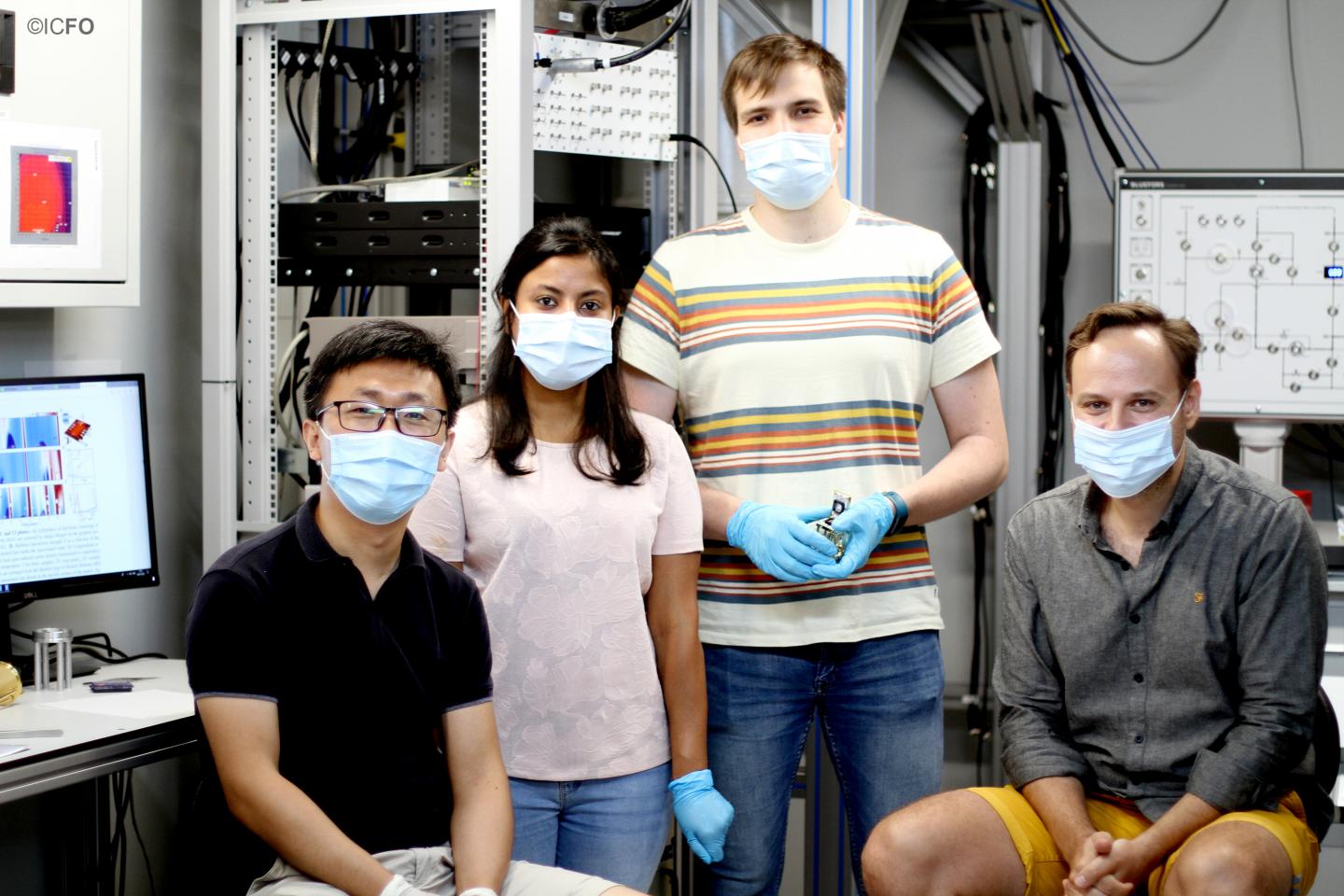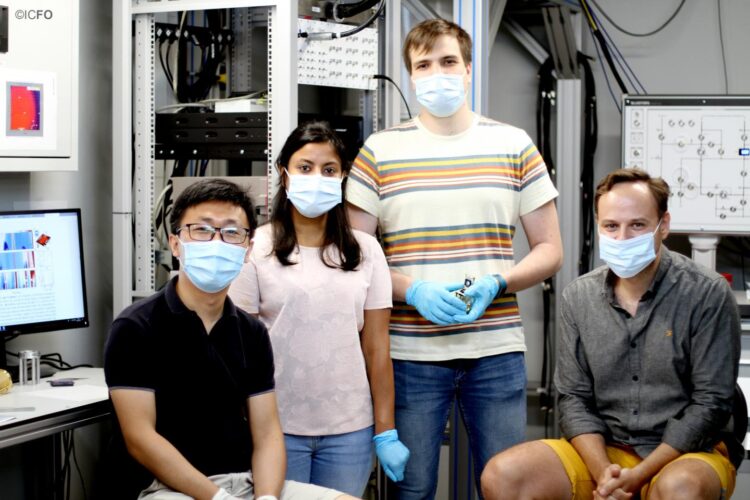
Credit: ©ICFO
If you stack two layers of graphene one on top of the other, and rotate them at an angle of 1.1º (no more and no less) from each other – the so-called magic-angle, experiments have proven that the material can behave like an insulator, where no electrical current can flow, and at the same can also behave like a superconductor, where electrical currents can flow without resistance.
This major finding took place in 2018. Last year, in 2019, while ICFO researchers were improving the quality of the device used to replicate such breakthrough, they stumbled upon something even bigger and totally unexpected. They were able to observe a zoo of previously unobserved superconducting and correlated states, in addition to an entirely new set of magnetic and topological states, opening a completely new realm of richer physics.
So far, there is no theory that has been able to explain superconductivity in magic angle graphene at the microscopic level. However, this finding has triggered many studies, which are trying to understand and unveil the physics behind all these phenomena that occur in this material. In particular, scientists drew analogies to unconventional high temperature superconductors – the cuprates, which hold the record highest superconducting temperatures, only 2 times lower than room temperature. Their microscopic mechanism of the superconducting phase is still not understood, 30 years after its discovery. However, similarly to Magic Angle Twisted Bi-layer Graphene (MATBG), it is believed that an insulating phase is responsible for the superconducting phase in proximity to it. Understanding the relationship between the superconducting and insulating phases is at the centre of researcher’s interest, and could lead to a big breakthrough in superconductivity research.
In such pursuit, in a study recently published in Nature, ICFO researchers Petr Stepanov, Ipsita Das, Xiaobo Lu, Frank H. L. Koppens, led by ICFO Prof. Dmitri Efetov, in collaboration with an interdisciplinary group of scientists from MIT, National Institute for Materials Science in Japan, and Imperial College London, have delved deeper into the physical behaviour of this system and report on the detailed testing and screening-controlled of Magic-Angle Twisted Bi-layer Graphene (MATBG) devices with several near-magic-angle twist angles, to find a possible explanation for the mentioned states.
In their experiment, they were able to simultaneously control the speed and interaction energies of the electrons, and so turn the insulating phases into superconducting ones. Normally, at the magic angle, an insulating state is formed, since electrons have very small velocities, and in addition they strongly repel each other through the Coulomb force. In this study Stepanov and team used devices with twist-angles slightly away from the magic-angle of 1.1° by ± 0.05°, and placed these very close to metallic screening layers, separating these by only few nano-meters by insulating hexagonal boron nitride layers. This allowed to reduce the repulsive force between the electrons and to speed these up, so allowing them to move freely, escaping the insulating state.
By doing so, Stepanov and colleagues observed something quite unexpected. By changing the voltage (carrier density) in the different device configurations, the superconductivity phase remained while the correlated insulator phase disappeared. In fact, the superconducting phase spanned over larger regions of densities even when the carrier density varied. Such observations suggest that rather than having the same common origin, the insulating and superconducting phase actually could compete with each other, which puts into question the simple analogy with the cuprates, that was believed previously. However, the scientist soon realized, that the superconducting phase could be even more interesting, as it lies in close proximity to topological states, which are activated by recurring electronic interaction by applying a magnetic field.
Superconductivity with Magic-Angle Graphene
Room temperature superconductivity is the key to many technological goals such as efficient power transmission, frictionless trains, or even quantum computers, among others. When discovered more than 100 years ago, superconductivity was only plausible in materials cooled down to temperatures close to absolute zero. Then, in the late 80’s, scientists discovered high temperature superconductors by using ceramic materials called cuprates. In spite of the difficulty of building superconductors and the need to apply extreme conditions (very strong magnetic fields) to study the material, the field took off as something of a holy grail among scientists based on this advance. Since last year, the excitement around this field has increased. The double mono-layers of carbon have captivated researchers because, in contrast to cuprates, their structural simplicity has become an excellent platform to explore the complex physics of superconductivity.
###
Reference: Untying the insulating and superconducting orders in magic-angle graphene, Petr Stepanov, Ipsita Das, Xiaobo Lu, Ali Fahimniya, Kenji Watanabe, Takashi Taniguchi, Frank H. L. Koppens, Johannes Lischner, Leonid Levitov & Dmitri K. Efetov, Nature (2020) https:/
ABOUT ICFO
ICFO was founded by the Government of Catalonia and the Universitat Politècnica de Catalunya (UPC), both of which are members of its board of trustees along with the Cellex and Mir-Puig Foundations, philanthropic entities that have played a critical role in the advancement of the institute. Located in the Mediterranean Technology Park in the metropolitan area of Barcelona, the institute currently hosts 400 people, organized in 25 research groups in 60 state-of-the-art research laboratories. Research lines encompass diverse areas in which photonics plays a decisive role, with an emphasis on basic and applied themes relevant to medicine and biology, advanced imaging techniques, information technologies, a range of environmental sensors, tunable and ultra-fast lasers, quantum science, photovoltaics and the properties and applications of nano-materials such as graphene, among others. In addition to two state awarded Severo Ochoa accreditations of excellence, ICFOnians have secured 15 ICREA Professorships and 37 European Research Council grants. ICFO is proactive in fostering entrepreneurial activities, spin-off creation, and creating collaborations and links between industry and ICFO researchers. To date, ICFO has helped create 7 start-up companies.
Media Contact
Alina Hirschmann
[email protected]
Related Journal Article
http://dx.





